The Definitive Guide To 3D Printing
The manufacturing sector has experienced numerous changes over the decades. The integration of technological solutions in manufacturing is beneficial. They improve product quality, minimize resource waste and reduce turnaround time. Companies are embracing diverse 3D printing technologies to enhance manufacturing sustainability and produce complex consumer products. 3D printing applies to mass production initiatives and rapid prototyping processes to introduce new parts and products.
Evolution of 3D Printing Technology
The history of 3D printing technology dates back to the 1940s. Proponents of the technology provided theoretical interpretations regarding how the technology works. It was only until the 1980s that the theory transformed into practical application. This period ushered in a new era in invention design and prototyping approaches.
The technological breakthrough was accompanied by massive research into alternative printing technologies, manufacturing materials and post-treatment methods.
In the 1990s and 2000s, more companies ventured into the 3D printing space. This era saw advancements in original printing technologies. Different industries verified the viability of the printing solutions for the part manufacturing diverse parts and components. It was until 2009 that desktop 3D printers were introduced. Companies and individuals involved in invention design opted to develop small-scale printing equipment. That allowed hobbyists and non-manufacturing professionals to express their creativity by designing and printing multiple products.
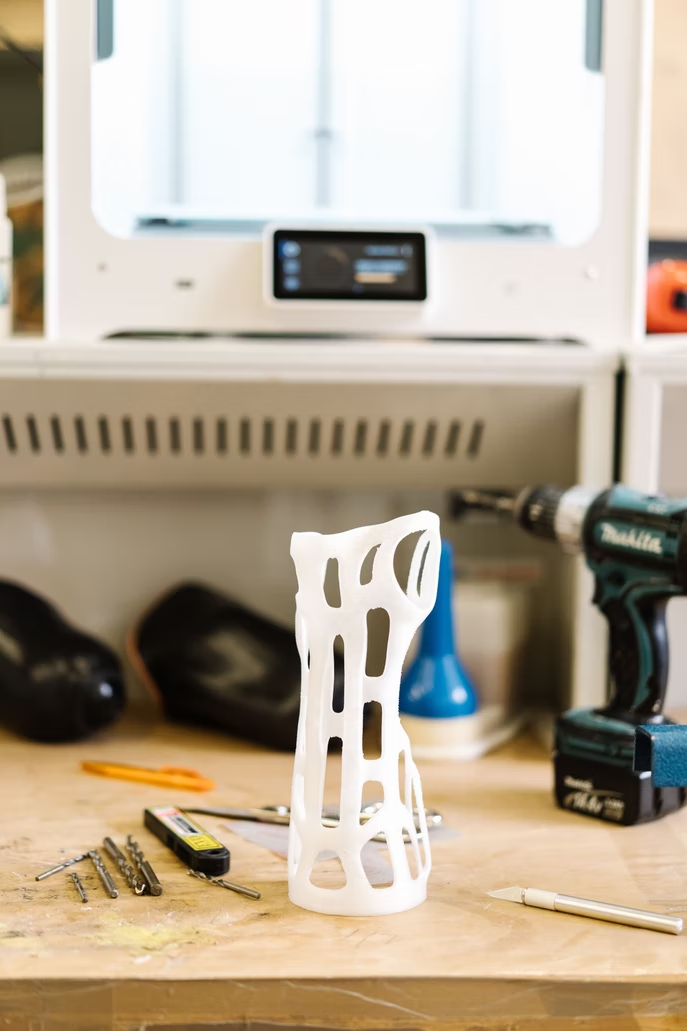
The introduction of desktop printers saw massive growth in the 3D CAD software market segment. Several companies developed suitable design software, offering them to customers at affordable rates. Innovators were no longer required to invest thousands of dollars in acquiring 3D CAD software.
Between 2010 and 2020, patents held by the pioneer 3D printing companies expired. The technology reached new levels, and its relevance in the product development process was established and validated. The expiry of these patents gave birth to a new breed of entrepreneurs. Experienced designers ventured into the service industry. During this period, several companies were established to offer 3D printing services.
The newer companies needed to innovate to beat the stiff competition from their peers. Some companies ventured into the manufacture of 3D printers and associated hardware. Others invested in manufacturing material research and development. They customized solutions with the needs of the target clients in mind.
These companies develop unique printing materials to meet the demands of different manufacturers and hobbyists.
More companies are venturing into the manufacturing as a service (MaaS) sector. They bridge the gap between product design and production.
These companies operate like e-commerce platforms. Their clients gain unlimited access to on-demand printing services as and when needed. This business model is critical for startups and one-time project coordinators as it allows them to develop products quickly and cheaply.
The 3D printing journey is far from over. 3D printing technology has found its way to all sectors of the economy. Initially, the technology was a preserve for the well-off companies, including aerospace.
3D Printing and Additive Manufacturing
Several 3D printing technologies exist in the market. Although each technology has unique features, all have similar execution. The term 3D printing refers to advanced manufacturing processes which allow the creation of physical products through a layer-by-layer fusion of materials. The formation of the physical object begins with the design of a digital 3-dimensional model on a computer. In simple terms, 3D printing is a process that converts digital 3D models into tangible (physical) products.
Sometimes, people mention additive manufacturing when referring to 3D printing. While additive manufacturing represents several other techniques, it has gained popularity due to the immense growth and adaptation of 3D printers for manufacturing and rapid prototyping. The popularity of additive manufacturing comes when companies and individuals are gearing towards net-zero emissions and sustainable manufacturing processes.
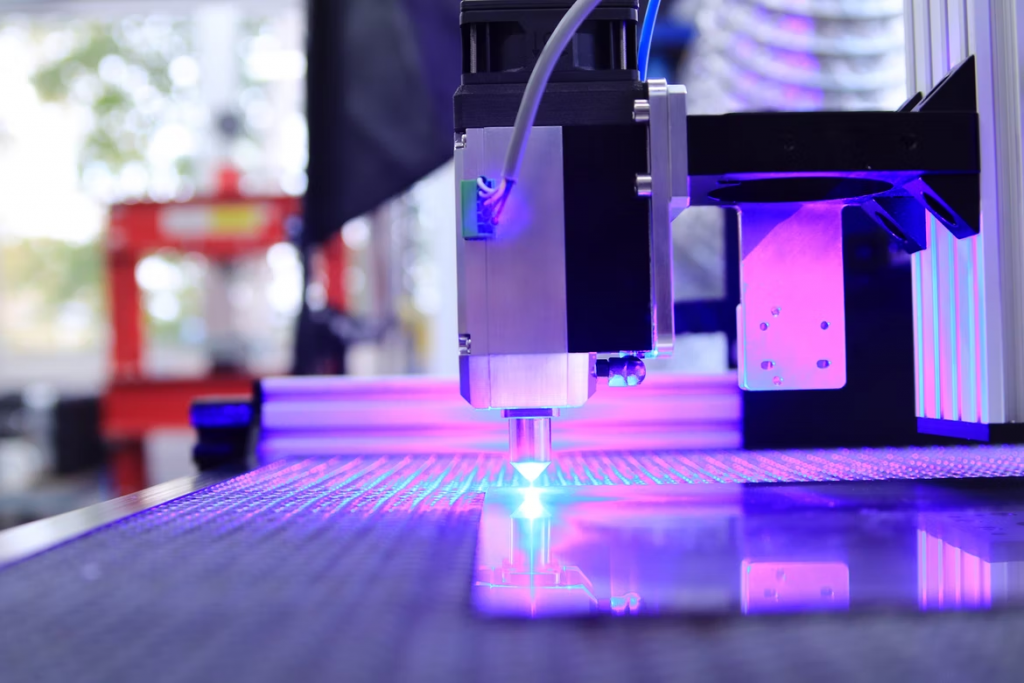
Printing new products using laser beam
The transition to 3D printing means companies are gradually eliminating subtractive manufacturing processes. The product creation process relies on expensive tooling to systematically strip off part of the stock material. The process is repeated until the desired form and shape of the object are achieved. Such manufacturing practices experience a myriad of challenges. The advent of 3D printing has enabled companies to overcome the shortcomings of traditional subtractive manufacturing practices.
Additive manufacturing methods sound complex on paper. However, these technologies are enablers of innovation and creativity in different industries. Printing technologies enable companies to eliminate expensive tooling and minimize material waste by significant margins. The efficiency of these technologies means companies can produce more consumer goods using fewer materials while enjoying better turnaround times. Who wouldn’t opt for a technology that guarantees quality products at a lower cost?
The presence of different 3D printer manufacturers implies that anyone can venture into manufacturing. Unlike in the past, innovators can invest a few hundreds of dollars and begin production on their premises. It challenges the notion that manufacturing is a capital-intensive venture. The efficiency of 3D printers goes beyond quick and accurate part production. It extends to energy consumption. These devices do not draw excess power from the mains for their operations.
All the jargon aside. How does the 3D printing process work? How does the process differ from the other manufacturing methods? The process begins with the computerized design of the desired product. There are several 3D design software tailored to meet the needs of different customers. In some cases, the innovator scans existing product models to create a digital 3D version that can be modified to improve usability and functionality.
Since many design software exists in the market, industrial design companies and individual designers can purchase enterprise or stand-alone 3D CAD solutions. Some enterprise versions allow multi-team collaborations and are accessible through cloud-based platforms. That enables remote teams to design consumer products collaboratively before prototyping and testing. Some individuals may lack basic design skills. They may lack access to specific product design platforms. This group, composed mainly of hobbyists and DIY enthusiasts, may access already designed products on several online libraries. Designers create multiple 3D models for products and share them with the general public. The hobbyists and 3D printing enthusiasts download these files and print them out for personal use.
After designing the product, designers convert the digital model into a format compatible with the 3D printer. Since the design process uses different software, the digital versions are saved in diverse file formats. However, 3D printers will begin creating products from CAD models if they are converted into a specific format. Most of these formats are universal. It implies that the product development team or the DIY specialist must access suitable conversion software. The converted file format is sent to the printer. The transfer process can be done using a USB disk, wired or wireless network, depending on the complexity of the printer.
After transferring the 3D CAD model, the printer interprets the entire design. The printer automatically slices the complex (or simple) models and creates virtual layers or nodes. The printer uses these layers to deposit the manufacturing material, layer after layer until the desired product design is achieved. Slicing is the process of converting the solid 3D model into thin layers. The process is vital as it facilitates the generation of material deposition codes (G-codes). The printing codes are instructions for the printing head to dispense manufacturing material or for the redirection of UV light necessary to solidify photosensitive polymers.
Different printers have different product qualities. The quality of the final product depends on the resolution of the printer. A printer with high resolution can print very thin layers of material.
Printing is done using a wide variety of materials. The most common printing material is thermoplastic material, with ABS being the most popular 3D printing material. Over the years, manufacturers and researchers have devised ways to 3D print complex shapes using metals, ceramics, fiber and other innovative materials. For instance, a 3D printer using plastic has a filament that extrudes heated material and deposits it layer-by-layer to create a replica of the digital CAD model.
The benefits of 3D printing surpass existing challenges. Nonetheless, innovators must understand that the preparation process requires plenty of time. The most technical aspect of the process is not printing. Instead, the designer must validate the digital design and be patient throughout the file conversion process. If one lacks product design and file conversion skills, they may fail to achieve their product development goals.
Another crucial thing to note is that some products require structural support during the printing process. Materials like plastic are generally weak (fluidic) when exposed to high temperatures. Failure to support such materials may cause distortion affecting the surface finish and quality of the final product.
Printing does not mark the end of the manufacturing or prototyping process. Few printing techniques require the designer to perform post-processing activities on the end product.
Selecting the correct 3D printing materials
When an innovator designs a product, they factor in the end-user needs. Every part of the product development process is performed with the end-user at the center of all decisions. The empathy enables the designer to strategically tackle technical issues and optimize product designs for customer satisfaction. It helps them simplify the selection process for printing techniques and manufacturing materials. So far, we know that manufacturers can choose from a wide variety of engineering materials. Why are certain materials preferred over others? Before settling on specific printing material, designers must evaluate:
- Desired physical properties of the end product
- Application area of the manufactured product or part.
- The desired structural strength of the final product
- Cost of production
The application area (or user environment) significantly affects the type of printing materials. Some usage environments are corrosive due to the heavy presence of chemical fumes or liquids. In some applications, the product is exposed to ultraviolet rays or high temperatures. The product designer must prove that the end product can withstand prevailing application extremities.
Most 3D printers use thermoplastics and thermosets. It is common to find 3D printers that use Acrylonitrile butadiene styrene (ABS), Nylon 12 or PLA. Specialized 3D printers can produce intricate metallic parts using finely ground metal powders. They allow designers and companies to create impressive consumer products and machine parts from different metals. There is also increased utilization of ceramics, sand and composites for 3D printing processes.
The designer should validate that the chosen printing material meets the minimum structural, physical and chemical conditions in the desired application area. Material selection decisions are also arrived at depending on the capabilities of the existing 3D printer.
3D printing Processes
There are different 3D printing techniques in use. Each printing technique has its advantages and disadvantages. Several printer brands are available in the market to suit the requirements of diverse companies, innovators and 3D printing hobbyists. Let us look at each of these technologies.
Stereolithography
Stereolithography (SL) is a popular 3D printing process that uses photopolymer resins. The printer has a laser that is concentrated on the printing resin. The photopolymer resin hardens when it comes into contact with the laser. The printer’s printing platform is movable. It allows the laser to hit the resin at different locations, solidifying it to form the desired 3D shapes. The photopolymer resin will harden at the areas in direct contact with the laser beam.
Often, the laser beam moves in the X and Y axes of the printer’s platform. After a complete layer is formed, the bed (or surface) of the 3D printer moves down slightly. The movement in the Z-axes is precise to ensure that the printed layers are of equal depth. The laser traces the shape of the 3D model. This process repeats until the desired shape and size of the product are achieved.
Once the printing process is complete, the part is removed carefully from the bed for post-processing. Typical post-processing activities include surface cleaning. In other cases, the object is exposed to heat treatment. The formed object is placed in an oven and left to cure for a suitable time under controlled light. The curing process is vital as it hardens the resin, making it stronger for the intended applications. Stereolithography is among the oldest 3D printing techniques. Its evolution has enabled product designers to create more complex 3D products with time.
The technique is suitable for manufacturing parts containing intricate details, tolerances and allowances. Using a laser ensures that the surface finish is as smooth as possible.
When creating products using this technique, it may be necessary to provide adequate support for the resins. It is important to support parts that contain undercuts or overhangs. These design features are fragile and may deform as the laser reacts with the photosensitive resins.
Stereolithography has gained popularity across several industries. The ability of the technology to facilitate the creation of parts with smooth surface finishes makes it critical for the manufacture of engineering molds, machinery parts, dental fixtures, prosthetics and innovative consumer products.
The availability of diverse resin qualities and formulations enables different designers and product developers to create a wide range of products with unique physical, chemical and mechanical properties that match or surpass popular engineering materials.
It is necessary to subject the final product to post-processing. Most products formed from stereolithography are brittle. It implies that they are easy to break. Exposure to light for an extended time reduces the brittleness of the product. The extensive post-processing is a disadvantage since it requires more time.
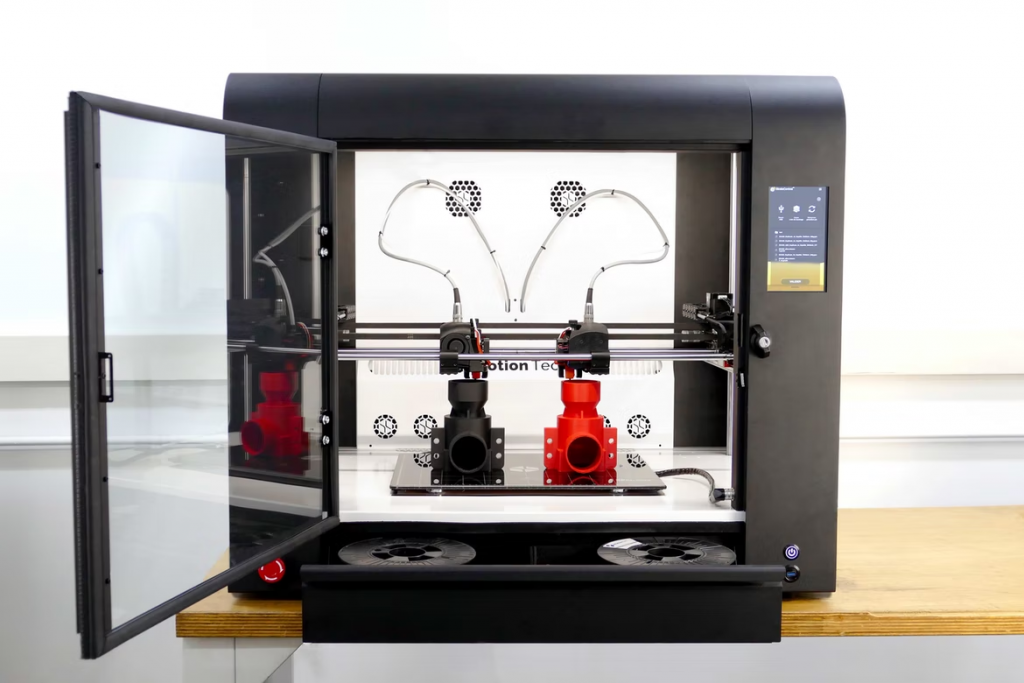
Desktop 3D printer with double extrusion heads
Laser Sintering
Earlier, we mentioned that 3D printing uses metallic and non-metallic materials. Laser sintering is one of the printing technologies that creates products from powdered materials. The printer consists of a moveable bed and a laser head. The printing process begins by laying down powdered material across the bed. A laser is concentrated on the printing bed. Its movement across the surface depends on the input data generated during the conversion of the 3D part design. As the laser moves in the X-Y axes, it melts the powder material. It causes the powder to melt and fuse, creating a solid layer.
Once an entire layer is fused, the powder bed is automatically lowered. The incremental drop of the powder bed allows the distribution of a fresh supply of powder material. The printer has a roller that spreads out the fresh powder to ensure even material depths. After the powder is spread, the laser begins melting it, fusing a new layer upon the existing one(s). The process continues until the full dimensions of the product are achieved.
When using laser-based 3D printers, keep the powder bed or printing chamber sealed. It is a deliberate process that maintains the temperature of the process to ensure the correct melting temperatures of the materials. After the printing process is complete, the formed part is lifted off the bed. Since this is a high-temperature process, the final product should be cooled. Excess powder remaining after the printing process is cleared off the finished product.
As the printing process proceeds, the initial solid layers formed by laser fusion of the powdered material act as supports for subsequent layers. It means that the printing process does not require the use of additional support. The bonds created between the layers support overhangs and undercuts, which are part of the 3D CAD design.
The surface finish for products created using laser sintering is not as smooth as stereolithography. These products are also porous. It means that excess gaps should be filled using fine materials to improve the mechanical and physical properties of the end product.
Although laser sintering is popular for creating metallic parts, it also proves vital for manufacturing or rapid prototyping with non-metals.
Laser sintering is known for its affordability. The cost per part is way cheaper compared to other techniques. The printing process is critical for prototyping and is a viable alternative to injection molding processes.
Direct Metal Laser Sintering
Direct Metal Laser Sintering technology was introduced by the American company 3D Systems. It is an innovative printing technique that eliminates expensive tooling and subtractive manufacturing processes to create precision metal parts. The process is similar to normal laser sintering. In this case, the build material is purely powdered metals.
Fabricating parts and assemblies using metals and their alloys enables product designers to create products with superior mechanical properties. The 3D printer has a dedicated laser head and a movable powder bed. The laser provides heat which melts the powdered metal. As the metals melt, they form thin solid layers. The laser beam path traces the exact shape and size of the designed or scanned digital model.
Using DMLS allows product designers to develop high-performance parts and incorporate special designs into end products.
The printing technique is a cheap alternative to processes like CNC machining for metal fabrication.
Electron Beam Melting
The printing process has striking similarities to the DMLS process. The breakthrough technology has enabled designers and developers from different sectors to produce unique parts using different metals and alloys. There are two differences between Electron Beam Melting (EBM) and Direct Metal Laser Sintering (DMLS). They are:
- EBM uses an electron beam to generate the heat required to melt and fuse powdered material. DMLS uses a laser to create the heat needed for the fusion process.
- EBM must be carried out in a vacuum
EBM technology has enjoyed immense success in the medical field. Most implants are developed using this 3D printing technology. The early success of this process has seen it advance to other critical sectors like aerospace and automotive manufacturing.
Digital Light Processing
Digital light (DLP) processing has numerous similarities to stereolithography. The printing technology utilizes photosensitive resins to create product parts or assemblies. The design of DLP and SL printers is similar. It contains a movable bed that moves up and down to facilitate the printing of products with suitable depths. The only difference between DLP and SL is the light sources.
In stereolithography 3D printing, the light that solidifies the photopolymer resin originates from a laser. However, digital light processing printers rely on light from conventional sources. Instead of a laser, the printer uses a lamp as the light source. It projects and concentrates light as per the 3D CAD design specification.
DLP creates new products faster than stereolithography processes. The light source applies intense rays to the resin on a wide resin surface. It means the photopolymer solidifies fast.
Although the end products have smooth surface finishes, they require curing. The printing also requires structural support to prevent the end product from deformation when printing. Digital light processing is cheaper than stereolithography. It allows product developers to create new products using shallow resins.
Binder Jetting
It is one of the 3D printing processes that does not require heating to form products. The prototyping or manufacturing device uses a printhead that sprays binding material on layers of powdered materials. The sprayed material is often an industrial-grade adhesive that holds powdered base materials.
The adhesive or bonding material is directed towards the printer bed, which holds finely ground material. Powdery material is distributed evenly on the flexible bed before a jet of adhesive material is sprayed on the thin layer. When one layer is complete, new charge of powder is supplied. The printer utilizes a roller that smoothens the new layer before the print head expels the adhesives. The printer supplies the adhesive to mimic the digital product model. The automatic printhead supplies adhesives at predetermined intervals, leaving sufficient time for the layers to fuse before introducing a new layer.
Binder jetting has similar advantages to laser sintering. The designer or product developer creates new products without using support to hold the part together. The powder bed and initial layers act as supports for freshly created layers. The printing technology allows the product development team to experiment with colors. The process enables the creation of aesthetic products while guaranteeing superior functionality. Binder jetting uses different materials. Apart from plastics and metals, innovators can create impressive products from biomaterials, food, ceramics and paper.
Products created using binder jetting may lack in terms of mechanical strength. These products require post-treatment to enhance their hardness and improve their durability.
Material Jetting
It is a unique 3D printing process that allows product developers to create parts from single or multiple types of materials. The product formation process uses a print head to eject suitable quantities of molten resins (or building materials) onto the build bed. Usually, the build material is a photopolymer that reacts with UV light. Once the molten material has been sprayed on the build bed, concentrated UV light is projected on the surface. The light traces the shape of the digital model. The process repeats until the final form and size of the end product are achieved.
Jetting the material is done layer-by-layer. Once UV light strikes the photopolymer material, it solidifies, allowing the deposition of a fresh charge of molten build materials. The printing technique facilitates the creation of products with mixed chemical and physical properties.
Material jetting 3D printers have high precision. It allows designers to create parts bearing specific dimensions and tolerances. The end products have smooth surface finishes.
Extrusion/Fused Deposition Modeling
Extrusion or fused deposition modeling (FDM) is a popular 3D printing technology. FDM is a technology that has been in existence since the 1990s. FDM was pioneered by Stratasys, a company specializing in 3D printers and technologies. The printers deposit layers of molten plastic filaments, layer by layer, following data input from the digital CAD files. The filament passes through a heated extruder which ejects molten plastic filament accurately. As the extruder moves in the X-Y axes, original plastic layers harden.
The hardening of plastic layers forms strong bonds between layers. FDM 3D printers use specific filament materials to create products. Most FDM printers use ABS or PLA as the build materials.
When dealing with complex part or product geometries, product developers must provide support during the printing processes. The printing support can be:
- Soluble materials- this is a material that dissolves when put in water. The designer washes off the support once the printing process is complete.
- Breakaway material- this is a support material that is compatible with the build material but physically weak. The support snaps off when slight force is applied.
Invention design in the 3D printing sector has enabled product designers to develop new printers that can create products through fused deposition modeling without structural support. The solution to this old problem is the use of dual extrusion heads. The innovation eliminates bulk of the challenges associated with part deformation during the printing phase.
Fused deposition modeling or extrusion uses accurate devices. It implies that designers can create superb consumer products using entry-level printers and achieve similar product qualities as industrial-grade printers.
The process has a few limitations. The layer-by-layer material extrusion proves to be slower when dealing with specific part geometries. Slow material deposition may affect the quality of adhesion between layers. Consequently, the polymer layers may become porous. Therefore, product designers must perform post-treatment on FDM-created parts. One popular post-treatment technique is using Acetone to resolve adhesion and porosity issues.
Some printing materials are supplied as sheets. That does not limit the use of 3D printers to create unique products using sheets. The process stacks and laminates several sheets of materials and cuts them to suitable sizes. Other lamination processes occur in reverse. The printer cuts the sheets to desired sizes before lamination.
Lamination is among the simplest 3D printing methods. Printing is achieved through:
- Laminated object manufacturing (LOM)
- Ultrasonic consolidation (UC)
In laminated object manufacturing, an adhesive is applied between the sheets of material. The printer begins forming parts by subtracting physical features, one layer after another, until the desired part shape and size is achieved. The subtractive process depends on other manufacturing techniques like CNC milling or water jet cutting.
When using ultrasonic consolidation, sheets of material are bonded using ultrasonic welding. The sheets are exposed to ultrasonic waves, which cause ultrasonic friction. In the process, the materials fuse due to friction welding. It creates a solid piece of 3D material.
Lamination uses different manufacturing materials, with paper as the most common printing material. The process can utilize polymers, metals, fiber-based materials and selected ceramics.
Lamination enables product developers to create products bearing layers of different materials as long as they are compatible. The process creates unique products with varying horizontal appearances.
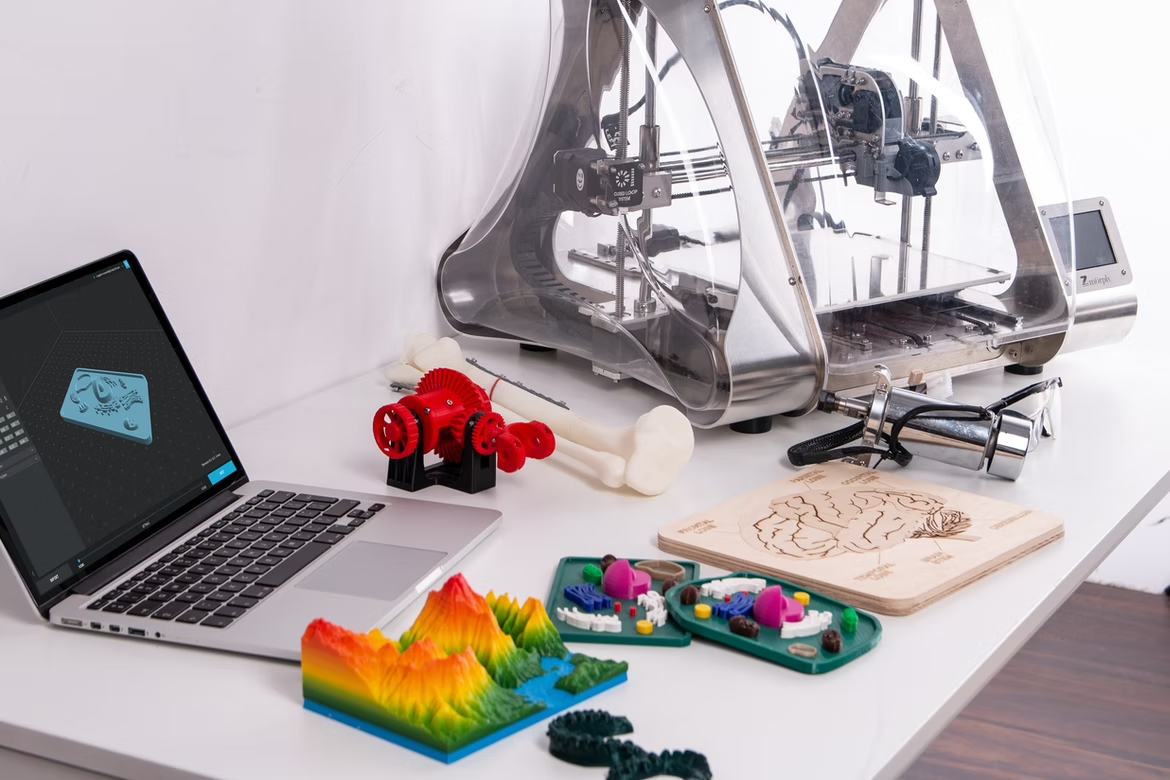
3D CAD models must be converted to a format that is readable by the printer
Why you should use 3D printing
Speed
The modern manufacturing space is experiencing tremendous growth and competition in equal measure. Consumer trends change by the day. An industrial design company that wishes to maintain its relevance amid the market dynamics needs to implement innovative strategies to streamline its product development processes.
3D printing is a blessing to established, medium and small manufacturing firms. The technology enables innovators to create new products within a short time. A new product may move from the conceptualization stage to prototyping in a couple of hours. The designer creates the relevant 3D models, conducts simulations, and converts the original design formats (STL files) into printable file formats. The automatic manufacturing device produces a functional prototype that designers and companies can utilize for functional product tests.
3D printing enables the fast-paced development of ideas and prepares companies for early market penetration.
Freedom to design and customize
Traditional manufacturing methods had several limitations. The design of complex parts was limited. It was because of the complexities associated with manufacturing processes. It means finer product details were omitted. With 3D printing, design for manufacture (DFM) is simple. The printing heads can automatically embed internal product features and replicate complex consumer product designs. The limitations to what one can design and manufacture have been lifted.
In terms of customization, designers no longer need to invest in different tools to manufacture different parts. A single 3D printer can produce medical-grade parts. The same can create spare parts for vehicles or bikes. Alternatively, the designer can develop textile products on the same machine. The innovator only needs to alter the manufacturing material to ensure that the final product meets the minimum requirements for use in different environments.
Cheaper production and reduced risks
3D printing technology reduces product development risks. It enables different innovators to conduct rapid prototyping and create proof-of-concept at the early stages of development. The innovator or company proceeds to mass production once they validate the demand for new consumer products and functionality. It is cheaper to produce 3D-printed parts. Everything in the product development cycle is remote. Product managers engage freelance designers who develop product parts per the client’s specifications. If the client does not have the printers on-site, they send the digital designs to companies offering 3D printing as a service. All these happen in a matter of days. The client receives a working product without investing in expensive production equipment and tools.
Selecting the best 3D printing process
Perhaps you are working on your first design project or seeking to revolutionize manufacturing processes in the company. You are pondering over which 3D printing method to adopt. We are aware of the different techniques available in the market, their benefits and their shortcomings. Despite this, individuals need to make several decisions before settling on a particular manufacturing technique and investing in a specific printer.
Before setting a budget, the product development team should identify its manufacturing goals. Are they going to 3D print for a one-off project? Or are they adopting 3D printers for the long term? It will assist them to choose whether to outsource the printing services and handle designs or perform all activities in-house.
Each printing technique has a cost attached to it. The product development team must weigh in on the short, medium and long-term expenditures against the potential revenues. It will help them vet the different 3D printer manufacturers and identify vendors who will provide lifetime product support. The budgeting process needs to factor in software requirements. It includes initial software purchases and subsequent upgrades.
In terms of hardware (printer) selection, the innovator or company needs to define:
- The type of material they will use for routine production
- The desired functionality of the end products and expected product qualities (surface finishes and mechanical properties)
- Technical specifications of the printer (how fast is it? How accurate is the 3D printer? What are the size limits for the end product?)
Innovative Applications of 3D printers
Since printing technology has undergone an immense revolution, manufacturers have developed large-scale printers to facilitate the production of structures other than machine components and specialty parts. In the early stages, the technology was limited to certain manufacturing sectors. The printing technology has matured in the health sector, aviation industry and security sector (firearms). Recently, the research into fiber-based and concrete materials has enabled companies to explore new opportunities. Here are a few sectors that technology promises to revolutionize.
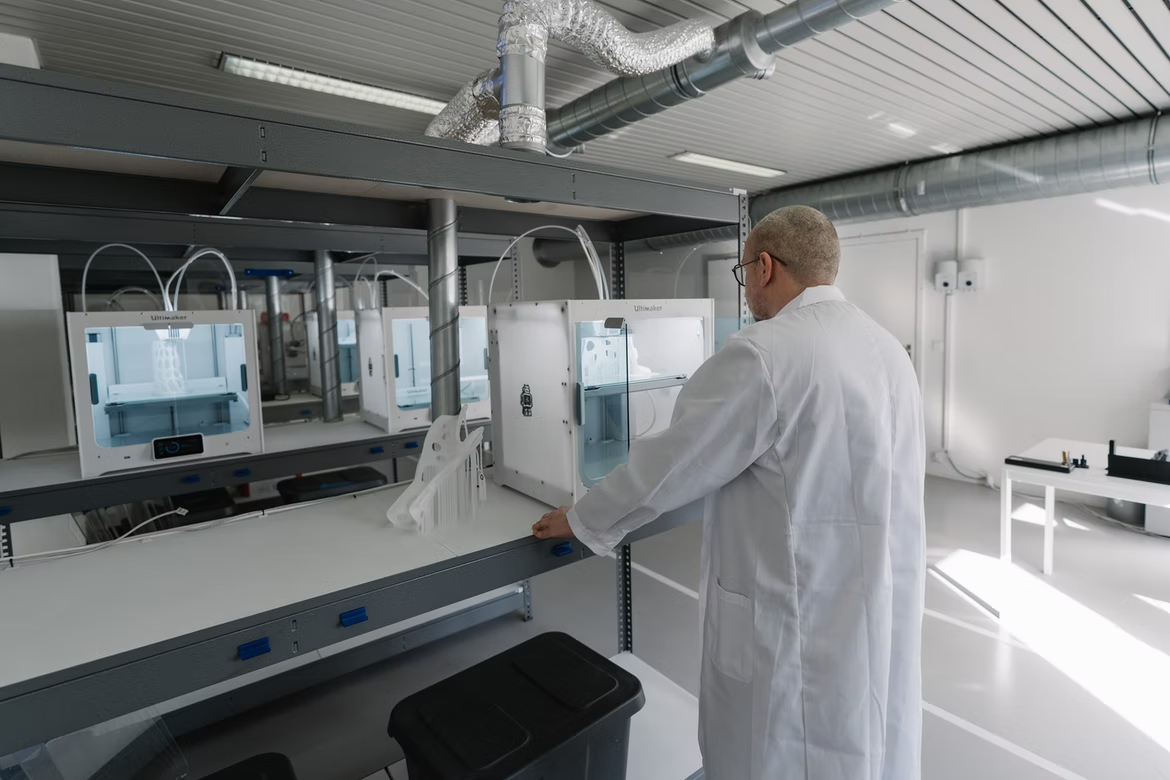
Typical 3D printer in action
3D printed civil structures
Large 3-D printers are capable of replicating architectural structures to construct sustainable housing. The technology is still in the infancy stages but is viable for small and medium-scale house construction. It has also been utilized to build bridges, like a recently unveiled pedestrian bridge in Amsterdam. The busy city bridge was created by 3D printing stainless steel using industrial-grade robotic devices.
As technology advances, these printers will be capable of automatically constructing megastructures and reducing turnaround time for critical infrastructure.
Preserving cultural heritage using 3d printers
Restoring ancient civilizations is an activity that most organizations and individuals hold dear. The erosion of past monuments has made restoration and protection efforts challenging. With the innovation in 3D scanning technology, it is becoming possible for engineers to redesign vital monuments. Cultural relics are recreated, forming digital twins. Organizations 3D print these models and keep them in museums to protect and restore monumental artifacts.
Additive manufacturing for the food industry
It is possible to reduce hunger using 3D printers. Scientists have developed suitable machines that squeeze out food from edible biomaterials. It creates layer-by-layer edibles and reduces production and packaging wastes. The innovation is a game-changer as it can help reduce world hunger.
Final Words
3D printing is a revolutionary technology with practical applications in different economic sectors. There is a lot of decision-making that goes into the printer selection process. The diversity of manufacturing materials and techniques allows industries, innovators and manufacturing hobbyists to create unique products with varying physical and chemical properties. There is room for 3D printing technology to mature and challenge traditional manufacturing methods.
